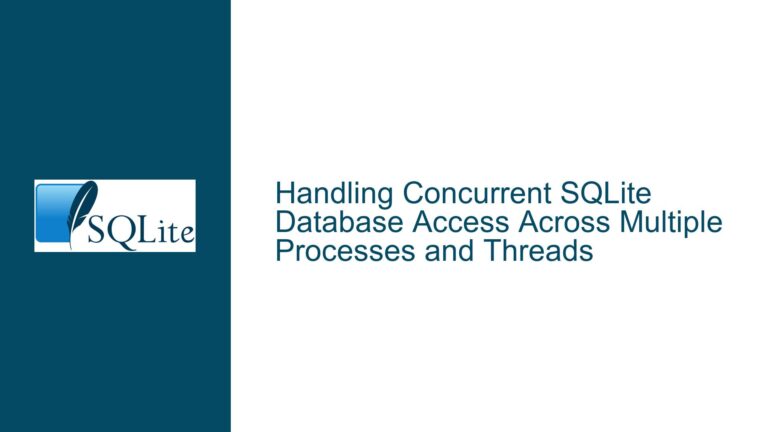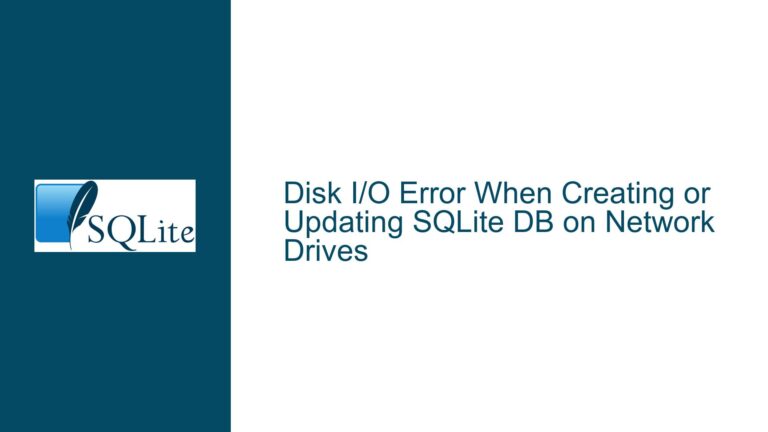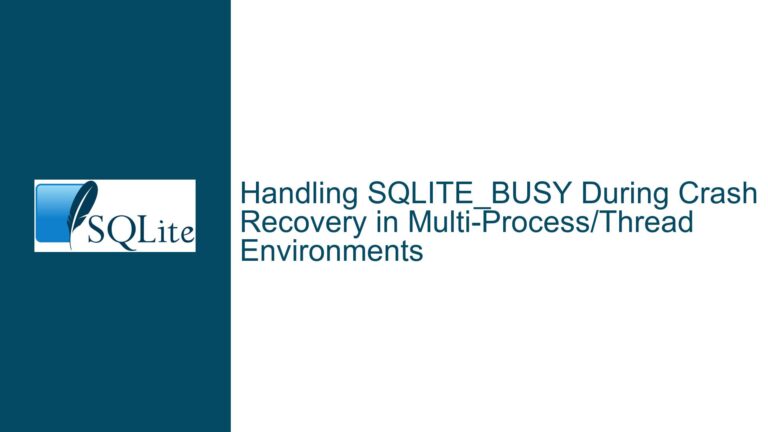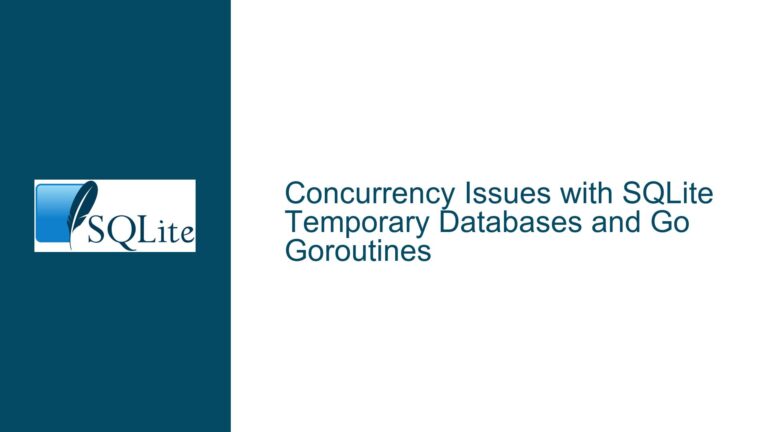SQLite Database Corruption Risks with vfork and execl
Understanding SQLite Connection Behavior Across vfork and execl
The core issue revolves around the behavior of SQLite database connections when a process forks using vfork and subsequently calls execl in the child process. The primary concern is whether the database connection, opened in the parent process, remains safe from corruption when the child process executes a new program via execl. This scenario is particularly relevant in environments where lightweight processes are used, and SQLite is the database of choice due to its simplicity and efficiency.
SQLite is designed to be a lightweight, serverless database engine, but it comes with specific constraints regarding process forking. The SQLite FAQ explicitly warns against carrying an open database connection across a fork() due to potential locking issues and database corruption. However, the use of vfork introduces additional nuances because vfork is a special case of forking where the child process shares the parent’s memory space until it calls exec or _exit. This raises questions about whether the same risks apply when vfork is used instead of fork.
The provided code snippet demonstrates a scenario where a SQLite database connection is opened in the parent process, and a detached thread is spawned to perform database operations. The parent process then calls vfork, and the child process immediately invokes execl to execute a shell command. The critical question is whether this sequence of operations can lead to database corruption or other undefined behavior.
Potential Causes of Database Corruption in vfork and execl Scenarios
The risk of database corruption in this scenario stems from several factors, primarily related to how SQLite manages file descriptors, locks, and memory during process forking. When a process forks, the child process inherits the parent’s file descriptors, including those associated with the SQLite database. SQLite relies on file locks to manage concurrent access to the database, and these locks are tied to the file descriptors. If the child process modifies the database or its locks in any way, it can interfere with the parent process’s operations, leading to corruption.
The use of vfork complicates this further because the child process shares the parent’s memory space until it calls exec or _exit. During this period, any changes made by the child process to shared memory, including SQLite’s internal state, can directly affect the parent process. Even though execl replaces the child process’s memory space with a new program, the brief period between vfork and execl is critical. If the child process performs any operations on the inherited SQLite connection during this window, it can corrupt the database.
Another potential cause of corruption is the interaction between the detached thread and the forked process. The detached thread continues to operate on the SQLite connection independently of the parent and child processes. If the child process modifies the database or its locks before calling execl, it can create race conditions with the detached thread, leading to inconsistent database states.
Additionally, SQLite’s internal cleanup mechanisms, such as those invoked by sqlite3_close, are not designed to handle scenarios where a connection is inherited across a fork. If the child process attempts to close the inherited connection, it can trigger cleanup activities that interfere with the parent process’s operations, potentially leading to data loss or corruption.
Mitigating Risks and Ensuring Safe SQLite Usage with vfork and execl
To avoid database corruption and ensure safe usage of SQLite in scenarios involving vfork and execl, several precautions and best practices must be followed. These steps address the root causes of the issue and provide a robust framework for managing SQLite connections in forked processes.
First and foremost, it is essential to avoid carrying an open SQLite database connection across a vfork. The child process should not inherit any SQLite connections from the parent process. Instead, the child process should open its own connection to the database after calling execl if it needs to perform database operations. This ensures that the child process operates on a separate connection, eliminating the risk of interference with the parent process.
If the child process does not need to interact with the database, it should avoid any operations on the inherited connection. This includes refraining from calling sqlite3_close or any other SQLite functions that might modify the database or its locks. The child process should focus solely on executing the new program via execl and exiting cleanly.
In the provided code snippet, the detached thread poses a potential risk because it operates on the SQLite connection concurrently with the forked process. To mitigate this, the thread should be synchronized with the parent process to ensure that no database operations are performed during the critical window between vfork and execl. This can be achieved using mutexes or other synchronization mechanisms to coordinate access to the database connection.
Another important consideration is the use of SQLite’s SQLITE_OPEN_FULLMUTEX flag, which enables serialized threading mode. While this mode ensures thread safety, it does not address the risks associated with process forking. Therefore, relying solely on this flag is insufficient to prevent corruption in forked scenarios. Instead, the focus should be on proper process and connection management.
If the application design requires sharing database access between multiple processes, alternative approaches should be considered. One option is to use a client-server database system that is explicitly designed for concurrent access by multiple processes. Another option is to implement a proxy process that manages database access on behalf of other processes, ensuring that only one process interacts with the database at any given time.
In summary, the key to avoiding SQLite database corruption in scenarios involving vfork and execl lies in careful management of database connections and process interactions. By ensuring that the child process does not inherit or modify the parent’s SQLite connection, synchronizing access to the database, and considering alternative architectures for shared database access, developers can mitigate the risks and maintain the integrity of their SQLite databases.






